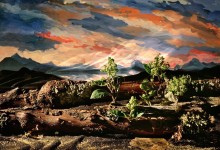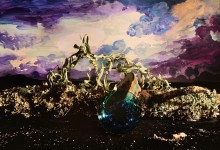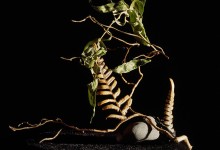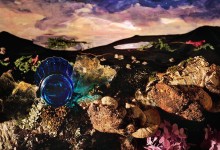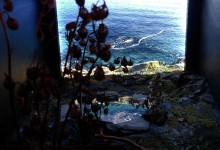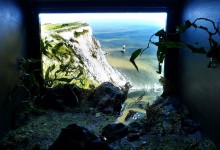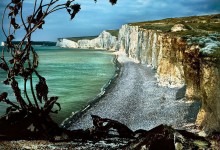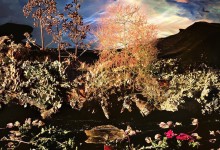Opening reception: Saturday, March 4, 2017 from 3-5 p.m.
Holly King: Edging Towards the Mysterious
Art Mûr, Montreal (QC)
Text by Isa Tousignant
Are you an outdoorsy type? Do you love the real landscape as well, or just the construct?
I think I like both. I do spend a lot of time in nature – I live in the Eastern Townships – but landscapes were always what spoke to me when I was a very young child, and they still do. To me landscape is often fraught with a kind of psychological import. In my work I like to give a sense of uncertainty, or a sense of the sublime, a sense of something that’s not entirely graspable.
What got you started on the analog type of set building? Do you have a theatrical background?
Sort of, yes. Originally I started working with performance art. For about five years I did performances and toured in different museums and galleries. The relationship with that and the photographs I do now is that somewhere around 1983 or ’84 I began staging performances in my studio only for the camera. I would build a set and perform within it. A couple of years later I decided not to work with the figure anymore, and of course I was able to shrink the size of the maquettes.
Where those performance sets also landscape based?
They were landscapes and mythological in reference, and they had art historical and architectural elements as well.
What scale do you work at now?
The set table is about one square meter in size.
In addition to photography, your work involves lots of painting and drawing. Like in the Forests of Enchantment series, are those black tendrils painted on glass placed between the lens and the set?
Yes, it’s India ink on acetate placed in the foreground. A lot of people thought I drew on the photograph. I was interested in the idea of a visual screen, the idea of moving into a landscape and being stopped, so you have to submerge yourself more slowly. My sets are very hands-on. My training was originally as a visual artist and not as a photographer. To this day I teach drawing and painting at Concordia University, not photography.
I’d even say you sculpt.
Sculpting, drawing, painting… you can see all those influences in the work. In fact there are four new works in this show, and I’ve gone back to the painted sky for them.
Do you consider yourself an installation artist, in a way?
Not really, because to me that would have to be a whole lot bigger. I’ve never actually done that, though it’s something I’ve always wanted to do.
I can imagine that your actual sets would be really interesting to see.
They’re very humble. There’s a transformative aspect that comes from the mechanics of photography and the lighting of these pieces – the lighting is really critical. It’s the thing that I work and work and work and work. Without the photograph, the set doesn’t look like much! Although, for this exhibition I’ve built two viewing boxes. They’re wooden boxes on tripods where, using forced perspective, I’ve built inner very miniaturized landscapes. It was a super interesting project to do.
Would you say you’re driven more by the investigation of artifice or landscape?
Oh, landscape. But there is a tension between the believability and the landscape. My works aren’t meant to be perfect illusions; they’re meant to question our understanding of landscape and how we view it.


